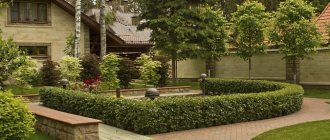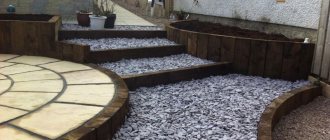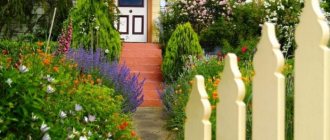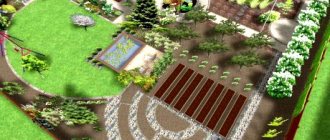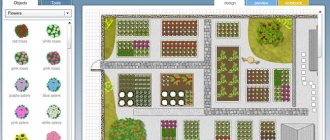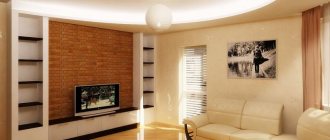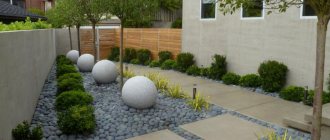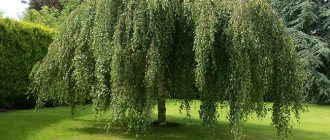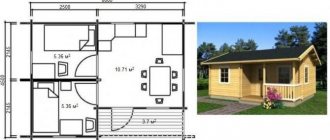Examples of garden layouts
A summer resident who has received the right to use the land strives to use it with maximum benefit. In order for the final result to look neat, it is necessary to plan everything correctly and make sure that both the plantings and the buildings do not interfere with each other.
Even on a small plot, with the right arrangement of objects, you can make a full-fledged garden and place a vegetable garden in it, create a recreation area and create beautiful landscaping. It will be much easier to do this if you choose a style in advance and know what plants you want to grow in your dacha. Their choice should depend on various factors: climate characteristics, degree of illumination of the area, personal taste preferences.
There are ready-made examples of garden layouts. They can be taken as a basis and used in landscaping a country house.
The easiest way to properly plan your plantings is to choose a rectangular shape. It will be the easiest to implement. To do this, you need to take a site plan, indicate on it the location of the house and outbuildings, and divide the remaining territory into several separate sections with clear boundaries. And already within their framework, planting plants, creating separate compositions that can decorate the local area. The rectangular layout of the vegetable garden is most suitable for those who own narrow, elongated plots.
Rectangular shape of the garden Source prakard.com
A circular layout always looks impressive. It is the exact opposite of the first; its implementation will require the knowledge of a professional landscape designer. Such concepts can be implemented with the help of flower beds, laying out lawns, and organizing patios. It is not difficult to create individual elements; it is difficult to connect them with each other and arrange them into one composition. This is usually done through skillful combination and several rounded shapes. In any garden there may be corners and straight lines; experts recommend hiding them with the help of climbing plants. This layout is most suitable for owners of square garden plots.
Circular garden layout Source landera52.ru
If you need to visually increase the volume of a small area, you need to use a diagonal layout. When implementing it, landscape design elements (paths, garden paths, hedge planting) are located along lines diverging from the house at an angle of 45 degrees. This technique helps to visually make the area longer or wider. The effect depends on which direction the lines diverge.
Example of horizontal layout Source nedvio.com
When such motifs are used, any area acquires a clear structure and finished appearance. An orderly form and a couple of bright accents are the key to success. Even if there is a small area, strict symmetrically located lines will bring the desired flavor to the space. A free layout is good when there is complex terrain, when there is a pond and large trees on the site. Such a garden will be the easiest to care for; in such a situation, there will be no need to carefully and closely monitor the plants, or care for them with special trepidation.
Even carelessly planted plantings should not create chaos and confusion. Even in an open-plan garden, key points should be marked. They can be arches and pergolas, gazebos and flower beds.
Open plan garden Source decoor.net
See also: Catalog of companies that specialize in landscape design of sites.
If perennials, then the most unpretentious
In choosing perennials for the garden, much depends on the taste of the owners of the territory, their desire and ability to care for the selected plants. For example:
- Peonies. They are magnificent - they bloom beautifully and are fragrant, but require regular fertilization, pruning of foliage and watering before flowering.
- Daylilies. These will grow well in the sun. And even when they fade, they will remain neat.
- Hosta, with its white and lilac bells in its carved foliage, is an excellent option for shady and semi-shady locations. It feels great even between trees, but it is not recommended to plant it right next to the trunks. As for care, after the first frost the leaves of the plant need to be cut off and the remains mulched with earth for the winter.
- Irises (Siberian and marsh) love moist, sunny places. They are extremely easy to care for - when it gets cold, all you need to do is trim them. But “bearded” irises are difficult to breed: they often get sick, are picky about the planting site, and need weeding and shelter for the winter.
- Lupines, daisies, rudbeckias. These flowers are very persistent and look great in rabatkas (elongated flower beds) and mixborders. Grown directly from seeds in the ground.
- Turkish carnations and hollyhock roses. Such biennials are also an excellent option for flower beds and mixborders. And they are easy to grow. But you need to keep in mind that they begin to bloom only in the second year after planting. And then they need to be removed and replanted, otherwise there will be no lush flowering.
Implementation of plans
After the style and landscaping scheme have been chosen, you need to create a sketch and mark the location of the main objects on it. It is important to mark everything on it: a house, a bathhouse, a gazebo, a fence, electric poles, and even those trees that are already growing on the site and that will remain on it after clearing the territory.
On the plan you need to mark the location of the cardinal points and use a stroke to indicate the height of each object. It will help you understand where the shadow will always be. These places are not suitable for a garden; there you can arrange paths, lay out a lawn, or build a pond.
Then you can begin to designate places for planting large fruit trees. No more than seven trees can be planted per hundred square meters. As they grow, they will cast a shadow and interfere with each other. If the tree fights for light, it will not have the strength to set and ripen the fruit. Experienced gardeners pay attention to the fact that with proper and regular pruning, up to 15 trees per acre can be planted. These activities will require some effort and time. If there are none, then it is worth reducing the number of trees planted to a minimum.
Sketch of the future garden Source muzicadl.com
Cherries and apricots are not subject to pruning: their fruits are located along the entire length of individual branches. Apples and pears need pruning. This makes their fruits larger and their number increases noticeably. From such trees you need to form balls, the height of which should not exceed two meters. If such trees are planted close to the fence, then it is necessary to form a flat shape using pruning.
Trees are planted every four meters; the distance between them can be filled with bunches of fruit and berry crops (currants, gooseberries). It is better to form rows from south to north, then the shadows from them will form much less.
Flowering trees and more
Landscape design experts recommend that new gardeners leave all large trees on the site. And build your garden around them. After all, without large, solid trunks under spreading crowns, it is difficult to achieve a sense of scope and natural luxury on the site.
Young trees also need to be planted, but we should not forget that they grow for quite a long time, so any operational effect cannot be achieved with their help. Such plantings will show themselves in all their glory only after a few years, which means they can only work for the future.
It is worth adding to the existing trees in the garden:
- beautifully blooming apple trees, plums and cherries;
- bird cherry (in its red-leaved form);
- horse chestnut with its charming “candles”;
- and Manchurian walnut in openwork leaves.
Space for a vegetable garden
Modern garden and vegetable garden projects on the site are distinguished by their originality. Many people strive to disguise the beds as much as possible and make them part of the landscape design. There are a huge number of ideas that allow you to clearly see how this can be done. Today, lettuce beds can look like flower beds, cabbage patches can become part of vertical landscaping, pumpkin foliage can decorate arches and pergolas, and tomato beds can form green rooms.
Flower beds with flowers and lettuce Source ogorod.mirtesen.ru
Whatever form is chosen to create a vegetable garden, growing plants must adhere to existing rules.
- For a family of four people, there is no need to plant a large vegetable garden; no more than fifty meters of land can be allocated . With proper placement of plants, it will not be difficult to harvest a very large harvest.
- Vegetable plants do not need as much light as fruit trees, so the garden can be planted where there is no shade from midday to evening .
- If the beds are raised to a height of 30 cm above ground level, this will have a positive effect on productivity .
- Climbing plants , such as peas or beans, are best planted in round flower beds and placed in the middle a pyramid connected from wire . Over time, the plants will completely weave it, and a very beautiful landscape design element , which will look organically in the chosen stylistic concept. At the same time, it will be much easier to collect the fruits later.
An original decorative element helps to grow beans and peas Source emprendiendo.club
When planning an assortment of vegetables, you should try to combine varieties with different flowering and ripening periods. First, early plants are sown (lettuces and radishes, herbs), then zucchini and peppers can be planted between them. When the first ones disappear, the second ones will delight the eye with their greenery.
French style
Such a garden must be carefully thought out; it requires special attention and care. The features of this style are straight lines and symmetry.
This garden requires a flat area without changes in terrain. There is a house in the center, and paths go from it in different directions.
The territory should have round ponds, canals, and fountains. Low-growing plants are planted closer to the building.
How to create your dream garden
Correct planning is not only the correct location and placement of the main landscaping objects. It is still necessary to try to connect all the plantings with each other and create one overall picture.
When you have a small plot of land and you want to have everything on its territory, a garden, a vegetable garden, a flower garden, and a lawn, you need to learn how to combine flower and vegetable beds, and use large flowerpots or pots instead of the usual beds. Parterre lawns and vertical compositions entwined with climbing plants always look impressive. To place them, you need to use thoughtful routes: it is easier to plant flower and vegetable rosettes along winding paths. To plant loaches, choose places near fences and unattractive outbuildings.
Vegetable garden as part of the garden Source pinterest.ru
A country house looks very festive if trees of a beautiful spherical shape are planted next to its facade. Garden beds framed with boxwood borders look equally expressive.
Flowering shrubs
If you need to completely relieve yourself of worries about the garden, it is best to create a multi-layered composition of beautiful shrubs. In this case, it is necessary to place the bushes along the perimeter of the site: near the fence and next to buildings.
The varieties should be chosen the most picturesque, bright, with an abundance of foliage. Such a garden must have:
Common lilac requires virtually no care other than pruning after flowering. These are lush flowering bushes with a magnificent aroma that fills the surrounding area in May. For a “lazy garden”, the varieties “Beauty of Moscow” and “Nadezhda” are best suited, but you can choose others.- Bladderwort. This one can grow in a sunny place into a huge beautiful bush. One of the most striking varieties of the plant is “Diablo” with dark foliage. So he will need to be planted.
- Mock orange (or garden jasmine). This one looks amazing and also does not require any complicated care.
- Derain is white, variegated. It blooms beautifully in spring, turns charmingly pink in autumn, and its red branches look expressive even in winter. Derain is planted in moist soils, where it develops well. As for the compositional solution, the place of this plant is in the back of the garden, since it behaves quite aggressively towards other bushes.
- Rose hip. First it is decorated with magnificent flowers, and then with bright red berries. It all looks very beautiful.
- Forsythia. With regard to this shrub, each garden owner decides for himself: to have it or not to have it? It begins to bloom very early and blooms unusually: small yellow inflorescences strew its bare branches. But for the winter, the plant must be covered with lutrasil, bending the branches to the ground. And this is quite troublesome.
- Spiraea (gray, Japanese, Vanguta, etc.). This plant looks great and is very easy to care for, regardless of the variety. Of course, it will decorate a “lazy garden” area, allowing its owners to simply relax.
- Hydrangea (tree-like, paniculate). The plant is a decoration for semi-shaded garden areas. Looks absolutely luxurious on its own and in an ensemble with conifers.
- Barberry. This shrub does not bloom very decoratively, but the beautiful red berries in the dark foliage look very beautiful, so barberry (ordinary or Thunberga) can take its rightful place in the garden. Moreover, neither one nor the other variety requires practically any care.
- Willow whole-leaved variety "Hakuro Nishiki". Another shrub that does not require any hassle and is distinguished by high decorative qualities. Its foliage turns a delightful pale pink in the sun.
Decorative fence
To decorate fences, shrubs, vines and perennials are planted along the perimeter. For this purpose, special gratings and supports are attached to the fences. The fence can be decorated with artistic painting or zoned with the help of individual items suitable for each style. For example, accents in the form of unique inserts in the form of cart wheels or clay pots placed on a wicker fence are perfect for a rustic style.
The fence can be decorated with hanging pots with fresh flowers, or made multi-layered. The latter option involves several stepped levels at once, on which hedges are located, forming a single composition; it looks great.
Decorative camouflage
The art of camouflage is especially important for creating a complete and well-kept garden design. There will always be places and buildings on the site that it is desirable to hide from prying eyes, or even simply to divert attention. These can be unsightly objects that spoil the overall appearance and impression of style, or heavy structures that need to be given softness and vitality. In each case, various camouflage options are selected to play up a particular landscape design object or building.
High tech
The high-tech style involves the embodiment of the most daring ideas, unusual for other trends in landscape design. Complete freedom of creativity, along with the use of modern materials and designs, contribute to the creation of a unique atmosphere in the garden. Here you can create optical illusions using decorative lighting, any unusual shapes. Abstract solutions best characterize this style direction. Catchy accents on a light background will favorably transform the area, giving it uniqueness and expressiveness.
Style Features
High-tech style is suitable for areas of any size. The materials used are: plastic, metal, glass, as well as concrete and gravel. The shape of design elements can be different; both symmetry and asymmetry are allowed. Expressive lines of geometric and zigzag shapes create a unified whole. All components of the garden are reminiscent of a futuristic future.
Architectural elements of the high-tech style are distinguished by their laconicism; these are unique flowerpots for plants of strict geometric or non-standard fancy shapes, all kinds of supports for vertical gardening. Several types of plants are planted in flower beds at once; boxwood, thuja, and pyramidal cypresses look especially expressive. The design of flower beds is always maintained in the same style, with the absence of diversity and too lush dominance of vegetation. For general landscaping of the area, a garden lawn or parterre lawn is used.
Reservoirs play an important role when designing a garden in a high-tech style; they smooth out modern accents, as if breathing life into the resulting system. Small artificial ponds can come in a variety of sizes and shapes with concrete outlines, and they often form entire groups. The overall color scheme mainly consists of light shades, with bright accents; here it is important not to overload the area with too variegated tones.
Selection of plants
Flowers, grass, bushes and trees are purchased in accordance with the chosen direction. Tall crops are planted first. Afterwards you need to take care of the flowers, which are placed according to the developed scheme.
Designing a small garden requires special attention. All elements are carefully selected to create a beautiful landscape.
Roses are purchased for the garden, which can become a bright accent. To create compositions, choose hydrangea, daylilies, dahlias, and peonies.
